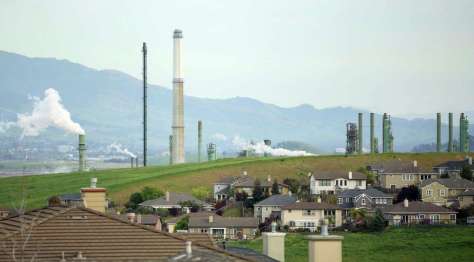Air District secures decisive victory: Chevron & MRC refineries drop lawsuits, Chevron to pay highest violation penalties in agency history

Record-breaking penalties & community funding mark a new chapter for the agency
BAAQMD Press Release, February 13, 2024
SAN FRANCISCO – The Bay Area Air Quality Management District announced today it has reached two separate agreements with Chevron and Martinez Refining Company resulting in an end to the litigation against the agency over its groundbreaking Regulation 6, Rule 5, major emissions reductions from both refineries, unprecedented penalties and other payments of up to $138 million, and a Richmond-area Community Air Quality Fund, among other benefits. The Air District estimates that the emission reductions achieved by the rule will result in tens of millions of dollars per year in health benefits by reducing early deaths and other health impacts of exposure to particulate matter.
Both agreements are related to the Air District’s enforcement of Rule 6-5, the most health protective rule of its kind in the nation. The rule reduces airborne particulate matter, or PM, emissions from petroleum refinery fluidized catalytic cracking units, or FCCUs. FCCUs are devices used in the manufacture of gasoline and are the largest sources of PM at these refineries. As a result of Chevron and MRC’s compliance with Rule 6-5, there will be an estimated 70 percent reduction of PM emissions from Chevron’s FCCU and an 80 percent reduction from MRC’s FCCU.
“The historic penalties and successful defense of our life-saving Rule 6-5 are a win for air quality in the Bay, especially those living in the Richmond and Martinez-area communities,” said Davina Hurt, chair of the Air District Board of Directors. “The establishment of the Community Air Quality Fund for Richmond further emphasizes our dedication to address the specific air quality concerns of the communities most affected, improve public health and to advance environmental justice.”
“The Air District’s agreements with Chevron and MRC mark a turning point in our commitment to enforcing air quality regulations and deterring future violations throughout the Bay Area, especially in communities already overburdened by air pollution,” said Dr. Philip Fine, executive officer of the Air District. “The record-breaking penalties and commitment by the refineries to comply with our health-protective Rule 6- 5 will help ensure a cleaner, healthier future for all Bay Area residents.”
“Defending our health-protective regulation to substantially reduce particulate matter from refineries and imposing significant penalties helps us improve air quality for all residents,” said Contra Costa County Supervisor John Gioia, who represents Richmond and is also a member of the Air District Board of Directors. “I believe everyone, no matter where they live, has the right to breathe clean air.”
“Protecting our communities from particulate matter 50 yards down the street from sources is as important as protecting these communities 50 years down the road from climate change,” said Mark Ross, Martinez Vice Mayor and member of the Air District Board of Directors. “Along with this settlement and the resumption of Rule 6-5, with its historic reduction in annual PM emissions, the Air District is also demonstrating that enforcement of episodic incidents and violations will be enforced vigorously. Bay Area residents deserve such protection for their health now and in the future.”
Chevron Agreement Highlights:
- Chevron drops its lawsuit and agrees to reduce PM emissions as required in the rule.
- Chevron pays unprecedented penalties for any delay in compliance past the regulation’s July
- 2026 compliance deadline. Chevron has committed to compliance with Rule 6-5 pollution limits, with escalating, record-setting penalties for non-compliance:
-
- $17M for year 1
- $17M for year 2
- $17M for year 3
- $32M for year 4
-
- Chevron implements interim PM emission reductions at the FCCU to obtain early reductions even before the regulation’s compliance deadline.
- Chevron pays into the Community Air Quality Fund, initiated with $20 million and supplemented annually by $3.5 million during the period needed for Chevron to construct air pollution controls. The fund will finance projects aimed at reducing PM exposures in the communities impacted by the refinery.
- Chevron pays a $20 million fine for 678 other violations at the refinery unrelated to Reg. 6-5 and commits to a series of measures designed to reduce persistent flaring.
- Chevron pays half the Air District’s attorney fees, up to $500,000.
MRC Agreement Highlights:
- MRC drops its lawsuit and agrees to fully comply with the regulation.
- MRC will demonstrate compliance with the regulation using a continuous monitoring system instead of periodic quarterly stack testing.
- MRC pays half the Air District’s attorney fees, up to $500,000.
The Air District’s landmark Rule 6-5 reduces particulate matter emissions from petroleum refinery operations and is the most stringent rule of its kind in the country. This groundbreaking rule outlines specific requirements for reducing, monitoring, and reporting emissions of various pollutants including sulfur compounds and particulate matter from refinery operations.
The Bay Area Air Quality Management District is the regional agency responsible for protecting air quality in the nine-county Bay Area. Connect with the Air District via X/Twitter, Facebook, Instagram and YouTube.




You must be logged in to post a comment.